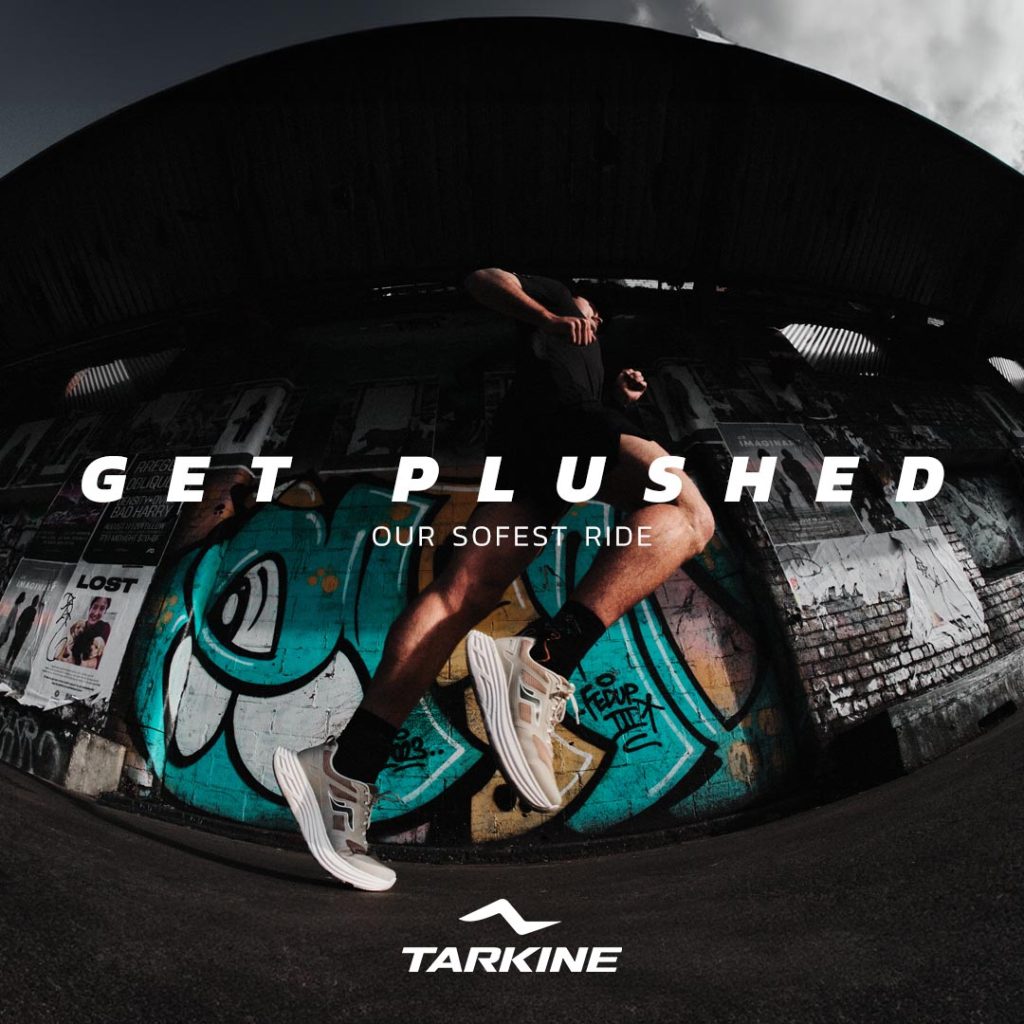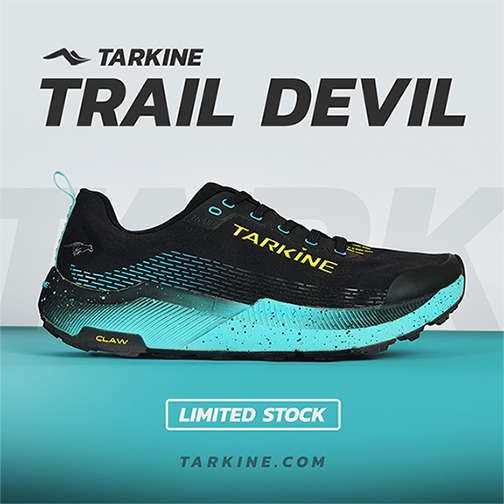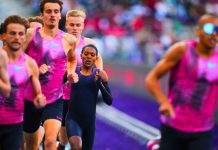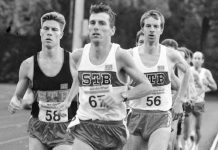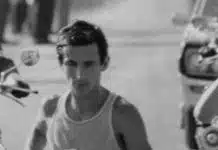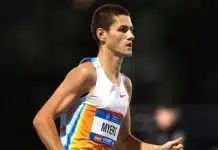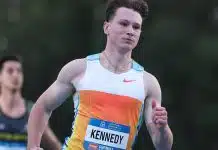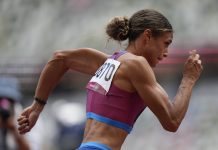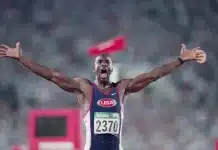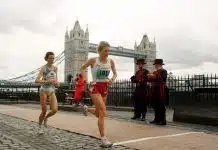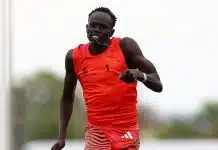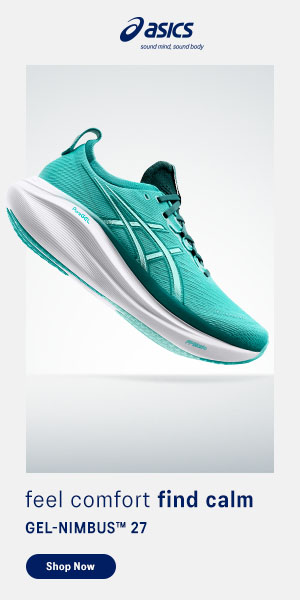This is original content from the outstanding website runculture.org run by Dane Verwey, a self confessed running junkie and 2:22:45 marathoner.
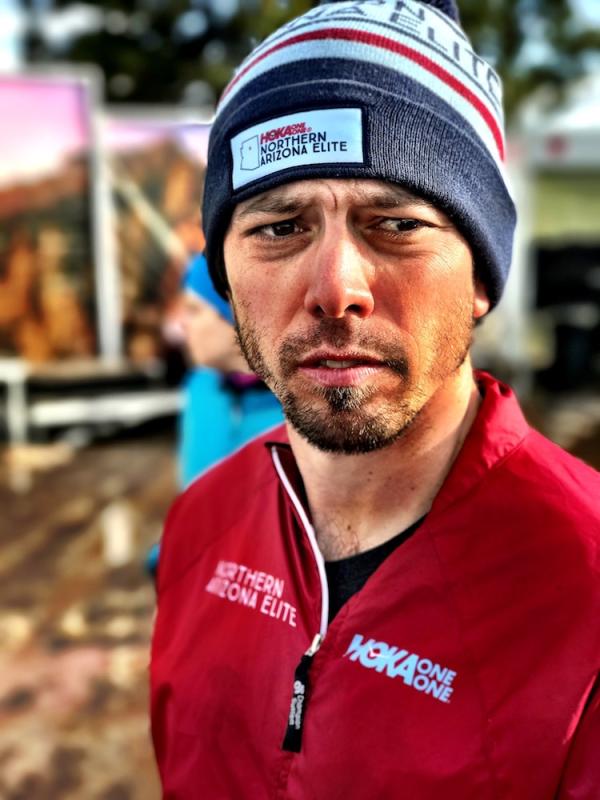
Ok Ben, let’s start from the start, I have read you fell in love with running at St Louis University High School back in the day. Your first coach was Jim Linhares who you eventually co-authored a book with, what do you feel it was that instilled this deep love of the sport you have? You are a ‘self-confessed’ sports nut but why did you choose/pursue running?
You have written many interesting blogs on your website; www.coachbenrosario.com but there is one that I particularly liked called ‘Forks in the Road’. I liked this blog as I feel we can all relate to it, if you haven’t read it please follow this link….. It illustrates that there are moments in life where you need to make tough decisions. When you have faced several big life changing decisions in your life you seem to have followed your ‘passion’. We will delve more into this as we progress through the interview.
What kind of level did you get to with your running at your St Louis University High School and then Division 2 Truman State University? Also, what did you study at Truman State?
In high school I got to what, in the U.S., we call “All-State,” meaning I was one of the top 25 runners in the State of Missouri. So nothing special really. I believe I ran 4:26 for 1600 meters and 9:48 for 3200 meters. Those were actually decent times back then, in the mid 90s, a period that was a real low point in American distance running. At Truman State I helped my team finish fourth at the Division II National Championships in cross country which was our biggest accomplishment. Individually I ran 14:27 for 5,000 meters and 30:11 for 10,000 meters. Again, nothing special. I studied communications with an emphasis in Journalism.
I want to delve into how you became a professional athlete with the Hanson Brooks team in Rochester hills, Michigan, with Keith and Kevin Hanson. Firstly, why was this your goal/dream?
I was completely hooked on the sport by my sophomore year in high school. By the time my college career was nearing its end there was just nothing else I was passionate about in life and continuing on was something I was almost desperate to do. And desperation can be an incredibly driving force in one’s life. I read an article about the Hanson’s team in Runner’s World magazine in the fall of 2002 and immediately it became my goal to join that team. It was a little out of the ordinary but I actually ran the Chicago Marathon that fall as I was out of cross country eligibility and the marathon was already where I saw my future. I had gone out to Colorado to train that summer and put in solo 90-100 mile weeks, thinking that maybe I could qualify for the Olympic Trials. The qualifying mark for men, at that time, was 2:22. I came through halfway in 1:10 and was still on pace at 22 miles before blowing up horribly over the last four miles. Still, that experience showed me I was close. That same fall I had a class called Senior Seminar, and one of our projects was to “apply for a job.” We had to prepare just as we would if we were truly applying and the final piece was a live interview with our professor in front of the entire class. Needless to say I was the only student who applied for a job as a professional runner. The professor must have thought I was crazy. But I remember he asked me, “What motivates you?” I responded that it wasn’t just one thing about running that motivates me. I told him I was constantly motivated–by my goals, from reading about top runners, watching races, by my teammates. And that was the truth. It was my whole life, for better or worse.
How did you make this transition happen? Did you reach out to them? Did they reach out to you?
They certainly didn’t reach out to me. They had no reason to. I was a nobody in terms of my times. But I put everything I had into convincing Keith and Kevin that I could be a benefit to their group. I copied the athlete bio page template they were using on their website at the time and dropped in my own picture and my own times as if I was already on the team. I also printed out my entire training log from my summer in Colorado and from the fall, training for Chicago. I dropped all of that into a manila envelope and sent it off. I was incredibly fortunate, and am eternally grateful, that they opened it up and somehow liked what they saw. I think, as much as anything, they appreciated my spirit and my obvious love for the sport. They had me up for a visit, we hit it off and they offered me a spot.
For the buddying/aspiring up and coming athletes out there what would your advice be in regards to all of this?
Well I have good news and bad news. The good news is there are more groups and more opportunities than there were back then. More athletes are able to move on from college and continue their runners careers at the professional level. But the bad news is that things have gotten so incredibly good in terms of depth that a runner with my credentials would never be able to nab a spot on a pro team these days. However, I would encourage anyone in that position to continue training and to find like-minded athletes of a similar ability level in their city or town and create a small training group of their own. When I left the Hansons in 2005 and moved back to my hometown of Saint Louis, Missouri, my running actually got a bit of a jolt as I spent the next five years running with a bunch of guys that enjoyed training hard but had full-time jobs–we had a lot of fun and a lot of success as well.
I’ve heard you reflect fondly about these two years at Hansons Brooks from 2003-2005. Tell us about your time there, who did you house with? What was the training like? It’s cold in Michigan isn’t it?
I had a blast. Those will always be two of the best years of my life. Not only because of the fun times I had there, but also because of the way it shaped everything that I have done since. When I first arrived I moved into a little two-bedroom apartment with Trent Briney (who would go on to finish fourth at the 2012 Olympic Trials) and Mike Fox (who had run collegiately at James Madison). Trent and I shared a room and both slept in mattresses on the floor. Needless to say, we didn’t have a lot of money. But that was what made it so fun. It was completely old school at first. We didn’t even have the Brooks contract when I joined. That actually happened about a month later, in September of 2003 I believe. It was all coming together during those years and I’ve told Kevin since that I think all of us who were on the team at that time were lucky because we were there when everything really took off.
The training was exactly what a guy like me loved. We ran…a lot. 120 mile weeks were standard. Out the door at six-minute pace every day. 20 mile hammer-fests every Sunday. I was in hog heaven. My talent, if I had one, was that I was durable. So even though the workouts were a huge challenge I could get up the next day and do it all over again. And to answer your question–yes–it was cold. Holy cow it was cold. The winter of 2003/2004 was the longest, nastiest prolonged period of cold weather I had ever experienced. But I really believed Keith and Kevin who always told us it made us tougher. They were right.
At the time Brian Sell was killing it, wasn’t he?
He sure was. It was clear he had already become the leader of the team by the time I arrived even though he was still young. No one could handle the punishing training like Brian could. And he thrived on it. I have said this before and I swear I am not lying–I spent two years on the team so that’s 144 Sunday long runs (minus the times he was out of town at a race or on downtime) and I never remember anyone finishing ahead of him. In those years, the long runs were totally unstructured. We’d meet at a location, usually one of the dirt roads outside of town, and off we’d go. It didn’t take long before we were under 6:00 pace and down it went from there. And everyone would take their swing. But that was sort of your rite of passage. If you could give Sell all he could handle on one of those long runs and never give in, then you had earned his respect. And once you had earned his respect you were his friend. And there was no better friend, or teammate, then Brian Sell.
I’ve heard you say; ‘Hansons have it right when it comes to marathon training’… ‘a steady diet of long grinding workouts’…a lot of you guys from that era have gone on to coaching; you, Luke Humphreys, Terry Shea. This is a real testament to the ‘Hanson’s’ philosophy isn’t it?! When training someone for a marathon Ben, what do you still use today that you learnt from your Hanson’s Brooks days?
A lot. I think the way we trained there still forms the basic outline of the way we train at HOKA NAZ Elite. Of course, that was 15 years ago so you pick up things along the way that you add to the mix. Or you take away this or that in favor of something else. Little things. But overall, the idea that marathon training is about putting in solid work, over time, with a big percentage of the faster work at, or around, marathon effort certainly remains my guiding principle.
What have you altered, modified or completely changed?
Well first of all let me say that they may have changed some of these things as well. I’m not sure. But our long runs are more structured. Most of them have some planned workout–be it a fast finish, or surges, or just a specific pace from the gun. I think, especially at altitude where we run much slower on easy days than athletes do at sea level, it’s important to make sure we’re getting the long run going and making it a truly hard day. We also didn’t do any ancillary work back then. But I’ve since become a big believer in it. So we’re in the weight room twice a week as a group doing very high-level strength and conditioning work. We’re doing a lot of form drills and plyometric work as well. Those are a few of the differences.
Answer this as you like but when you were running with Hanson Brooks professionally what did this look like financially? Were you on a salary? Did you get free massage? Free gear? Free board? Travel assistance?
I didn’t have any salary–none of us on the team did at that time. And of course I didn’t deserve one either. A 2:18 marathoner has no real market value so I am certainly not complaining. What I did receive was as much as I could have ever asked for. As soon as I arrived I received free gear and travel. Once I achieved “A” level status on the team (there was a two-tiered system back then) I got a job at the stores, free housing and health insurance (through the job at the stores). We also got other perks like a gym membership and discounts for chiropractic work. I can’t remember if we got some of that work covered completely or not but, regardless, it was very affordable.
As an athlete, you were a 2-time Olympic Trials Marathon qualifier, 2nd at the 2005 US Marathon Championships and had a pb of 2:18:53 marathon. Tell us about your marathon career. Do you feel you reached your potential?
Hey, for a kid with a 9:48 2-mile PR in high school, I’ll take it. Like you said, I got to run in two Olympic Marathon Trials. I got to train with some of the best runners in the country. I had tons of experiences, both racing and training, that I will never forget. I believe I got just about as much out of myself as I possibly could have.
How many marathon builds had you done before your PB?
I ran 2:18 at the Cal International Marathon in 2004. I was 24 years old and it was my fifth marathon. When I finished second at the Twin Cities Marathon in 2005 I only ran 2:20 but it was super hot and humid. Physiologically that was my best performance. Not sure what I would have run had it been a nice day but I think it’s fair to say it would have been a PR.
When you ran your PB at CIM were there indicators in training to suggest you were ready to run this time? I know we are harking back now haha but how did the race pan out?
At CIM I ran 2:18:53. As far as what I thought I could run I’ll tell you a funny story. I remember sitting behind the counter at the Hansons’ Royal Oak store and thinking about the race. It must have been a few days out. I took out a blue sticky note, I can remember it that vividly, and started imagining the race–not in some sort of dream-like way but in a really realistic way. I pictured what I could run each mile in and started writing them down one at a time. After I got to the end I added them all up and, I swear to you, it added up to 2:18:55.
As far as how the race played out, it was pretty much according to plan. I stayed right at 5:20 for ten miles or so and then started having some quicker miles here and there. From 18-23 I had to deal with what I can only assume was some sort of nerve issue I had at the time where my left leg almost felt like it was giving out. That was annoying because otherwise I felt totally fine. I gave up a few seconds during those miles but somehow I got my stride back to normal with a couple miles to go and felt great again. From 25 to 26 I actually ran my fastest mile of the race, 4:56, and sprinted home to get under 2:19. It was a cool experience.
In 2006 there was the next fork in the road in your life. You decided to start what later became a hugely successful running specialty store in St Louis called; Big River Running Company with your friend Matt Helbig. You built this specialty run store from nothing to 2 million in sales, it now has 4 sites across St Louis and has had a huge impact on the local running community. You also were race director for the Nike festival of miles charity track meet and later the US Cross Country Championships through this period.
You then needed a change, so it was off to Flagstaff Arizon with your wife Jen and daughter Addison to work as the marketing director with Greg McMillan at the McMillan Running Company. You and Jen on the side started up an online initiative called RunFanShop.com selling; shirts, posters, books and DVDs to cater for the niche market of the ‘running fan’. How did this go?
It was fine. We were breaking even but never really got a chance to see it through because once we started the team that became our main focus. I actually think someone could do much better with that idea today as I think the running fan base is more fervent than ever.
In addition to the shopping portion of the site, you started writing blogs and producing a podcast. You also started TeamRunFan, an elite development team (that soon became what is now know as Hokka One one NAZ Elite). Founding members included Matt Llano, Eric Fernandez and Jordan Chipangama.
Here, comes the next fork in the road, how did you know starting a professional running team was going to be viable? Yeah, we see the Oregon Track club, the Bowerman Track club, the Oregon project, Brooks beast, MTC, but other than in Japan corporately sponsored professional run groups are few and far between.
I have heard stories that you self funded the group (that had grown to 8) the first 6-12 months of the venture, spending $40,000, whilst not making an income. Firstly, take us through the stress of this ordeal? Your doubts? What stopped you from following financially safer but less fulfilling path?
It didn’t really feel stressful at first, it just felt fun and exciting. I didn’t have too many doubts. First of all I am a naturally confident person. I’ve been like that ever since I was a little kid. I went to every baseball, basketball or soccer game I played fully expecting to win. And if we lost I was devastated, but then I’d be right back at it and full of confidence by the start of the next game. Plus, when we started the team it didn’t feel all that different than starting the running store eight years earlier. I never thought about it but I am sure that experience turning out how it did helped as a I began this new venture. And as far as money, I never cared about that anyway. I grew up in a lower middle class family. We never had a lot of money so it never bothered me whether I had any or not. Still doesn’t bother me. That said, you do need money to survive so by the end of 2014 I was coming to the realization that if we didn’t get something done soon in terms of a title sponsor we might have to come up with a Plan B.
This is my favourite part of your story. You followed your passion, you wanted nothing more than to coach at the highest level and now it’s happening. What lesson could you impart to readers about this whole experience you went through?
I have come to believe that it’s very important to figure out who you are. To figure out how you’re hard-wired and in what environment you are most likely to succeed. For me personally, I need to be in charge. That may sound pompous but believe me it’s not. I am terrible when I’m not in charge. I lose focus. I get lazy. I lack any sort of drive. So for me, being the leader of a group or an organization is where I thrive. I need the stress that comes with responsibility. So following my passion, combined with learning who I am as a person, led me to where I am today. So in that context, my advice to anyone looking to follow their passion is to figure out where you best fit inside whatever industry you want to be a part of. Once you know that, then you go after positions that will put you in a situation where you can give just as much as you get.
How did you end up landing Hokka as the title sponsor? Do you feel the 6 years of running networks and experiences you had at the Big River Running Company helped at all?
Yes, I know for certain that my business experience helped us in our search for a title sponsor and, specifically, in our eventual deal with HOKA ONE ONE. Not necessarily in the negotiations themselves, as those were mainly done by Josh Cox–who brokered the deal, but more so in how we set up the team in the first place. From day one we knew that this whole thing was about creating a brand, a brand with true value that could then create an ROI for a company. Performance was, and is, a huge part of that value but only so much as it creates more eyeballs on your brand. What I am getting at is that your job as a professional athlete (or a professional team in our case) is to create awareness for your sponsors, plain and simple. At the stores, one thing we did really well, was to create a community around Big River Running. Eventually Big River Running Company wasn’t the brick-and-mortar stores, it was the people. It was our tribe. So what we tried to do with NAZ Elite was essentially the same thing but on a national/global level. We wanted our fans to feel a part of what we’re doing and who we are. It’s an ongoing process but I am very pleased with what we’ve been able to do so far and I am grateful to those fans because they have been vital to all of our success.
Finally, and I don’t know if I have ever told this story but you asked about the running network helping us get the deal so I will tell it now. One of my good friends in the running industry, and an incredible mentor, is Kris Hartner–owner of Naperville Running Company in Naperville, Illinois. Kris helped Matt and I when we first got Big River going and remained a constant source of knowledge through all of my years there. In fact, he and Matt are still very close more than a decade later. Anyway, Kris had followed my journey with NAZ Elite that first year and he liked what we were doing but he also knew what Jen and I were capable of having seen us build Big River from the ground up. I had called him to ask his thoughts about HOKA when we began talking to them and he had nothing but great things to say. And Kris knows everyone so of course he knew their marketing director really well. He told me he’d give him a call. I was super thankful but you never know when someone’s going to get around to doing a favor for you. Well, he didn’t wait long. He turned around and made the call, I think it was a day later and turns out it was just in the nick of time. The HOKA brass were just about to sit down for a marketing meeting. Kris was able to sing my praises seconds before the group discussed whether or not NAZ Elite would be a good investment for the brand. I don’t know what all was said but I do know that after that day things started rolling in the right direction.
In March this year you re-signed a multi-year deal that will take you through to the 2020 Olympic Cycle. You must be stoked about this?
It is tough to describe how grateful I am that HOKA believes in us to the extent that they do. I can only hope that I show that gratefulness each and every day, through the work I put in to making HOKA NAZ Elite the very best brand ambassadors we can possibly be. I described our initial deal with HOKA above. But we sort of had to go through the whole process again because of a regime change in their marketing department halfway through our first contract. In the end, it’s been amazing. Lee Cox–the global marketing and sales director for the brand, and Mike McManus–the sports marketing director, have been behind us 100%. Obviously, there are tough conversations you have to have on the business side but that’s just that–business. Once the contract was officially signed it was a relief for all involved and for us, we were able to move forward and just do what we do best.
There is a huge cloud of mystery surrounding pro runners that even a peek into what is available might inspire future runners. Are you able to provide any general details of your contract? The athletes’ base salary, bonuses, or other obligations? Do you get travel, camps, physio and/or housing assistance? (please just answer what you are comfortable answering)
The only reason there is such mystery is because typically shoe companies have what are called non-disclosure agreements as a part of your contract. Those NDAs prohibit you from revealing any of the specific details of your contract. Why exactly that is, I am not sure. You would have to ask them. All I can tell you is this–HOKA takes care of us. We’re able to provide salaries, bonuses, travel, gear, physio, strength and conditioning, blood work and more. We are a truly professional group. Take from that what you will.
You once said, ‘… anybody who is a gatekeeper for the sport. They need to get rid of the idea that promoting the professional side of the sport is dangerous and could hurt its mass appeal. It’s the exact opposite.’ I am in total agreeance with this. NAZ elite and all its members are so current and active on instagram and I’m sure I can speak for any aspiring distance runner it really is inspiring to see what you guys are up to. NAZ elite’s large social media presence and following, is a huge player in their success as a brand. You have almost created a ‘football’ like team for spectators to support and follow. However, does this huge following and the fact that the ongoing nature of your livelihood is ultimately determined by your runners success become a burden? If so how do you cope with this pressure?
I don’t feel that it is a burden, no. Of course I get down about a bad performance or an injury or things of that nature. But, because we have such a deep group it seems like a successful performance is always right around the corner to pick me back up. And I am still a huge fan of other sports as well. I think that helps me with perspective. I love the Saint Louis Cardinals baseball team but even in a great year they are going to lose 60-70 games. Failure is a part of the business of sports. If you can’t handle that part of the business you won’t last very long.
Last few questions, you are a busy man and I have kept you far too long. You can really see the Hansons Brooks influence when you look at NAZ elites training regime. You are a huge advocate that strength=speed and wrote an insightful blog on www.coachbenrosario.com that I wish more runners would appreciate ‘every workout is a 5k workout’, please visit read this article if you haven’t.
Just quickly, do you mind briefly talking through the concept of specificity when it comes to marathon training and how this concept can differ when it come to training for a particular marathon. Eg. Boston, New York, Chicago or Berlin?
Sure. I think our training, regardless of the athlete, is fairly similar all year long. We do a fair bit of mileage, we touch all the training zones all the time but put more emphasis on high-end aerobic training than anything else. I believe this allows us to then shift into some more specific work as we get close to a particular event, be it a 5k, a 10k, a marathon, etc. As it relates to training for a particular marathon I actually find that to be really fun. We have sort of a basic template that we use for the last 8-10 weeks before a marathon. And the general principles for the big workouts during those weeks are unlikely to change. But things like terrain or pace-variance can change and those changes are not only physiological but mental as well. Scott Smith, as a quick example, trained for one set pace in the fall of 2017 for the Frankfurt Marathon. Frankfurt is flat and fast and we were going for a time. So we trained on mostly flat roads. We did workouts that held a steady pace the entire time and our long runs were very structured. But then in the Spring, as he trained for the Boston Marathon we ran on super hilly roads. Paces were changing all the time based on the terrain and some of our long runs became as much about effort as they were about time. And I know he said he enjoyed the new challenges that those workouts provided.
3 weeks out you guys often do a 16 miler at marathon pace. This is just one of many marathon specific workouts you do in your prep. What do you like about this workout? Why have you kept it in there after all these years? Do you do a variation?
We usually do that workout either three weeks out or four weeks out. It just depends on the flow of the segment. In a shorter, more condensed segment I like it three weeks out. In a longer, more spaced out segment I like it four weeks out. But what I like about it as that it is as specific as you can get. You don’t get to stop in a marathon. So repeat workouts, though valuable will never be as race specific as a long steady run at marathon pace. Thus, these workouts take on an extra level of importance. But yes- we can vary the nature of this workout. If nothing else, I don’t want them always comparing it to a previous segment. So we’ve done it a 7,000 feet elevation in Flagstaff but we’ve also traveled and done it at 3300 feet and once we drove three-and-a-half hours to do it at 1500 feet. We’ve varied the course in Flagstaff, sometimes going “out” on Lake Mary Rd. which provides a slight net downhill. We’ve also done it “backwards” on Lake Mary where we’ll finish with a pretty brutal net uphill the last four miles. For Boston we did it on an absolutely crazy course with some major downhill, followed by an almost absurd couple of uphill miles, and then some flat at the end. This weekend, we had Scott Smith and Scott Fauble pace at the Chicago Marathon as their version of it. I think all that variation is good for the mind. Keeps us from getting too comfortable.
The 4 mile tempo/10 mile long run/4 mile Tempo workout and its variations, what do you like about this session? When should a marathoner use this in their build? What paces should a runner strive for in this workout? What are they trying to achieve by including this workout in their build?
I can’t even list all the variations we’ve tried with this one. I like it between six and ten weeks out, maybe even longer if you’re doing a more spaced out segment. The basic way to do it is four miles at marathon pace (or 2:10-2:30 race pace for non-elites), straight into 10 miles at about 45 seconds slower per mile than you ran the 4 miler, then straight back into four miles at marathon pace with the green light to cut it down a bit if you’re feeling good. Ends up being a great 18-mile run. So that’s part of the goal–to just have a great long run. The second big thing is to force the body to start burning pretty hot nice and early rather than slowly building into things like you’d do on a regular long run. This is much more like what will happen on race day and when you’re not prepared for it, it an lead to a “bonk.” Finally, I love the mental and physical challenge of running marathon pace (or even faster) at the end of such a long and difficult run.
And, last of all, what can we expect from Kellyn Taylor, Stephanie Bruce, Scott Smith and Scott Fauble in the coming months/years? Any predictions? Any other NAZ athletes we should be watching out for in particular?
In the short term you will see Steph, Scott and Scott at the TCS New York City Marathon on November 4. We have high hopes for that one as all three are in killer shape. Over the next 16 months much of what we’ll do will have the 2020 U.S. Olympic Marathon Trials in mind. As it stands today we’ll for sure have Steph, Kellyn and Aliphine Tuliamuk at the Trials on the women’s side. For the men we’ll have Scott and Scott as well as Aaron Braun who just ran 2:13:16 at the 2018 Bank of America Chicago Marathon. All six of those athletes will have a realistic chance to make the team. But watch out for everyone! Our younger athletes are coming around too. Alice Wright is our one British athlete and will have a great shot to make it to Tokyo. Futsum Zienasellassie is a huge talent and could be a serious factor at 10,000 meters or maybe even the marathon if he and I decide to give that distance a shot. And finally–Erin Clark, Grayson Murphy and Danielle Shanahan are all recent college graduates who are showing a ton of promise. So you never know. The goal is to just keep getting better. If we do that I think all will be well.
Ben, I can’t thank you enough, you don’t know just how appreciative I am of your time. Thanks for such a ripper interview that a lot of runners in Australia will not only cherish and gain a lot of inspiration but learn an absolute bucket load from!
Thanks Dane
Check out more awesome content at runculture.org



